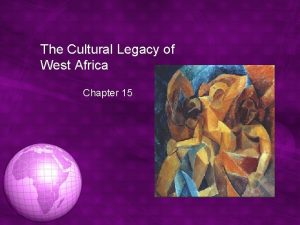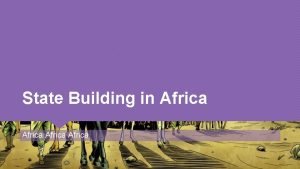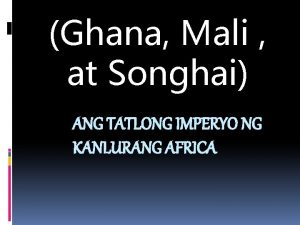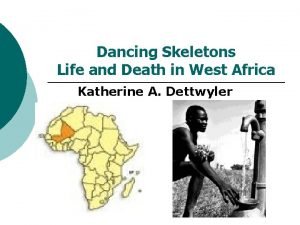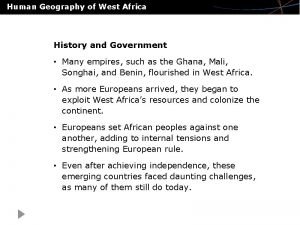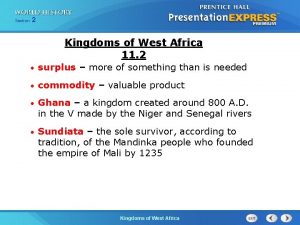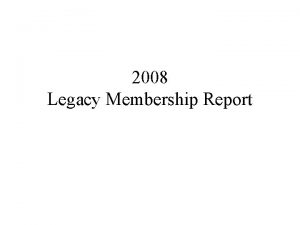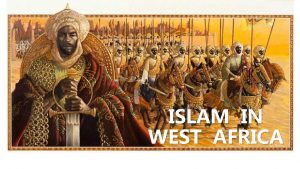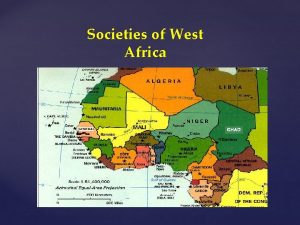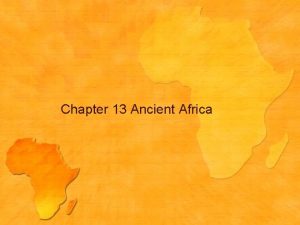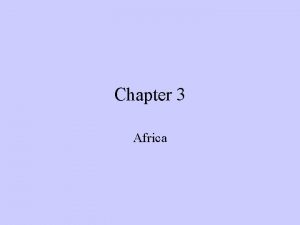The Cultural Legacy of West Africa Chapter 15











- Slides: 11

The Cultural Legacy of West Africa Chapter 15

Words you need to know • Genealogy – an account of the line of ancestry within a family • Folktale – a story that is usually passed down orally ad becomes part of a community’s tradition • Call and response – a song style in which a singer or musician leads with a call and a group responds • Terra-cotta – a baked clay often used to make pottery and sculptures • Appliqué – a technique in which shaped pieces of fabric are attached to a background fabric to form a design or picture

• Their culture is diverse • Poems and stories to music and visual arts • Oral traditions – stories, sayings and history of city so not forgotten kept by a griot – They helped preserve West Africa’s history and cultural legacy

West African oral and written traditions • Beliefs, values and knowledge of West Africans were passed from one generation to the next • Griots – record keepers of the people – verbal artist of Mande people – Tell stories, sing songs of praise and recite poems while playing a drum or stringed instrument – skilled entertainers – kept historical accounts and genealogies – Every village had their own griot – Tell the history of everyone in the village – Could speak for hours or even days – Passed from one griot to another – They were trusted advisors to the king

Folktales and proverbs • Folktales – Used to pass along history and to teach young people morals and values – Many brought to America with slaves – Trickster tale – story of a clever animal or human that outsmarts others (hare) • Brer Rabbit • Proverbs – Popular sayings – Images from everyday life to express ideas or give advice giving wisdom and values – “every time a man dies, a library is burnt down” • Written tradition – After Islam came to West Africa writing became important – Turned ancient oral tradition into novels and other works

West African music • Important part of life • Communicates ideas, values and feelings • Celebrates historic events and important occasions • Call and response – Leader sings a short phrase = call – Group answer by singing short phrase = response – Used to ease burden of hard work for slaves – Influenced gospel, jazz, blues, rock and roll, and rap • Musical instruments – Balafon – wooden bars across a frame – Ngoni – small stringed – wood – with fishing line – Kora – harp like with 21 strings – gourd and cow skin • All these instruments are still used today

Drumming • Drummers perform during parties, religious meetings, and ceremonies • Made of hollowed out logs and covered with animal skins • Drummers play in ensembles or groups with different sizes and types of drums. • Drumming, singing and dancing take place in a circular formation – sometimes a call and response style • Slaves brought the drumming traditions to America

Dance • Dance is as important as singing and drumming • Dance during rituals and ceremonies • Dance to educate children • Seek help from spirits • To connect with dead ancestors • Movements reflect conditions live in – Forest people look like they are moving through forest undergrowth – Sometimes wear masks to represent spirits of traditional West African religion

West African visual arts • Fabrics and basket for everyday • Masks and sculptures for rituals and ceremonies • Sculpture – – Used to honor leaders – Nok sculptures were made of terra-cotta – narrow heads, unusual hair styles and dramatic expressions – Yoruba made sculptures of terra-cotta and later bronze and copper – By 16 th century making elaborate plaques showing king’s power and authority • Masks – – Wooden masks worn during ceremonies and in sacred rites – Used to bring spirits of gods and ancestors into the present – Are detailed and expressive – Influenced Spanish painter Pablo Picasso

Textiles and everyday objects • Stamped fabrics, story fabrics, kente cloth • Use stamps to fill in squares with patterns – Represent proverbs, historical figures, objects, plants or animals – Story fabrics depict events (kings hunting lions) – Made appliqués attached to background pieces to make designs or pictures – Famous for kente cloth – narrow strips of silk or simple fabrics – with symbolic meanings that reflect history, values or beliefs • Everyday objects – Ceramic storage containers, utensils, furniture and baskets – Used coil method for basket – made tight so can hold water – Still made today

Summary • Cultural achievements of West Africans still influence today • Griots helped to preserve history and culture of West Africa • Folktales and proverbs part of oral tradition • Muslim scholars added written tradition • Call and response • Traditional drumming, instruments and dance • Visual arts –sculpture, masks, textiles, and everyday objects • Music and art vital in West African life
 The cultural legacy of west africa answers
The cultural legacy of west africa answers Residential school photos show legacy
Residential school photos show legacy Residential school photos show legacy erasure
Residential school photos show legacy erasure Salt and gold trade in west africa
Salt and gold trade in west africa Salt and gold trade in west africa
Salt and gold trade in west africa Swana
Swana Which ocean borders africa on the east
Which ocean borders africa on the east Ang imperyong mali ang tagapagmana ng ghana
Ang imperyong mali ang tagapagmana ng ghana Dancing skeletons dettwyler
Dancing skeletons dettwyler West african societies around 1492
West african societies around 1492 Human geography of west africa
Human geography of west africa How did the kingdoms of west africa develop and prosper
How did the kingdoms of west africa develop and prosper
